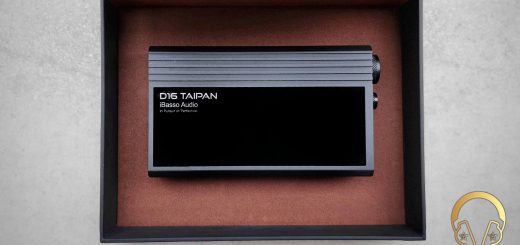FiiO SNOWSKY Melody Review
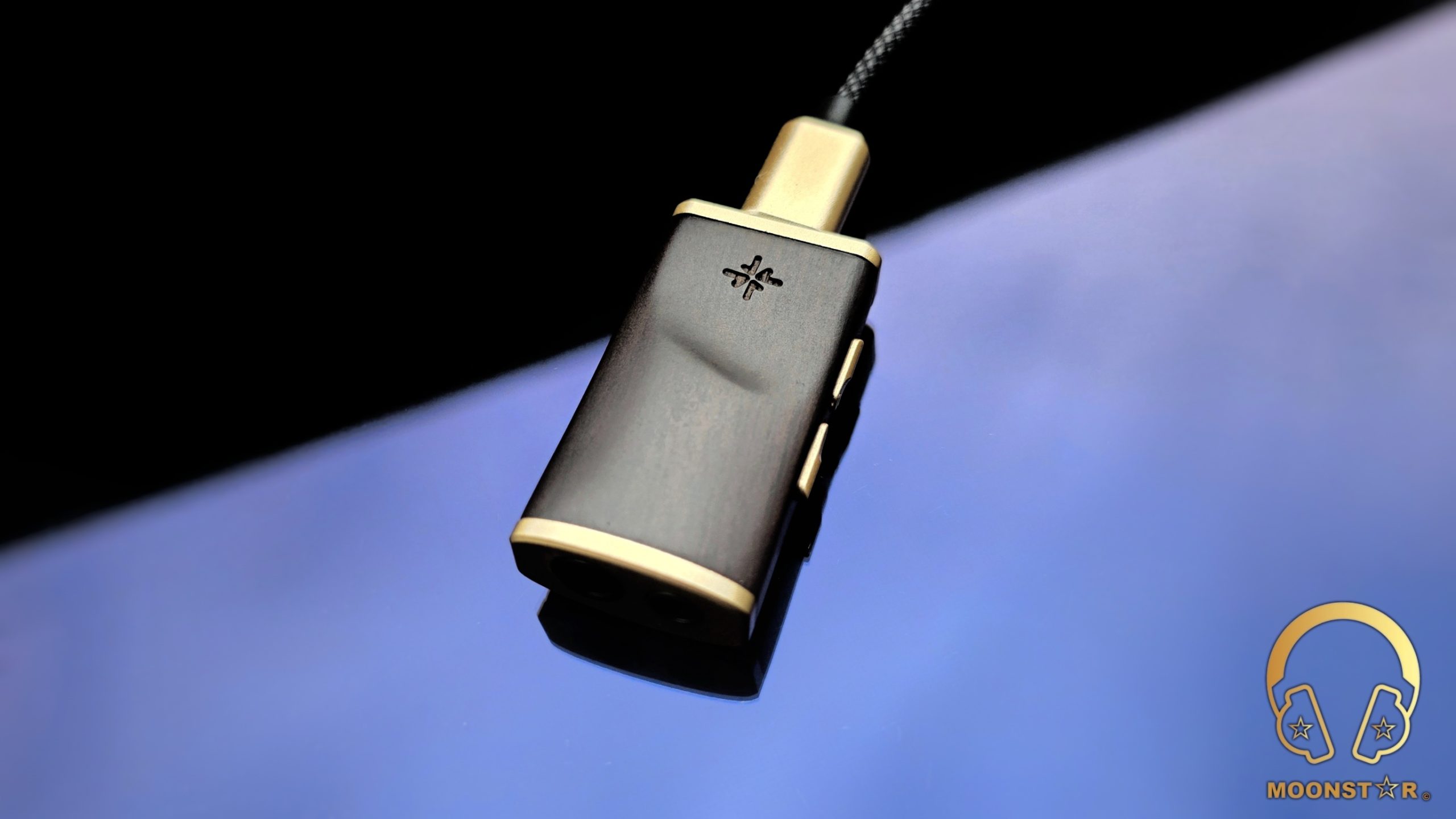
FiiO SNOWSKY Melody Review
Introduction:
The FiiO SNOWSKY Melody, a compact USB DAC/AMP from FiiO’s Snowsky sub-brand, aims to elevate portable audio with a blend of premium craftsmanship and high-fidelity performance. Designed for audiophiles and casual listeners seeking to enhance the sound quality of their smartphones, tablets, or computers, this device combines a unique wooden aesthetic with robust technical capabilities, including Cirrus Logic CS43131 dual DAC chips and versatile output options. This review explores its design, features, and sound performance to assess whether it delivers exceptional audio in a pocket-sized package.

Disclaimer:
I would like to thank FiiO for providing me the SNOWSKY Melody USB DAC/Amplifier dongle as review sample. I am not affiliated with FiiO beyond this review and these words reflect my true and unaltered, opinions about the product.
Price & Availability:
The FiiO SNOWSKY Melody is priced at approximately $39.99 USD, making it an accessible entry in the portable DAC/AMP market. It offers a compelling feature set for its price, positioning it as a strong contender for budget-conscious audiophiles. More information’s can be found under the link below;
Package & Accessories:
The FiiO SNOWSKY Melody arrives in a compact, eco-conscious box that prioritizes simplicity while ensuring the device is well-protected. The packaging is clean, with vibrant branding that hints at the premium experience inside.

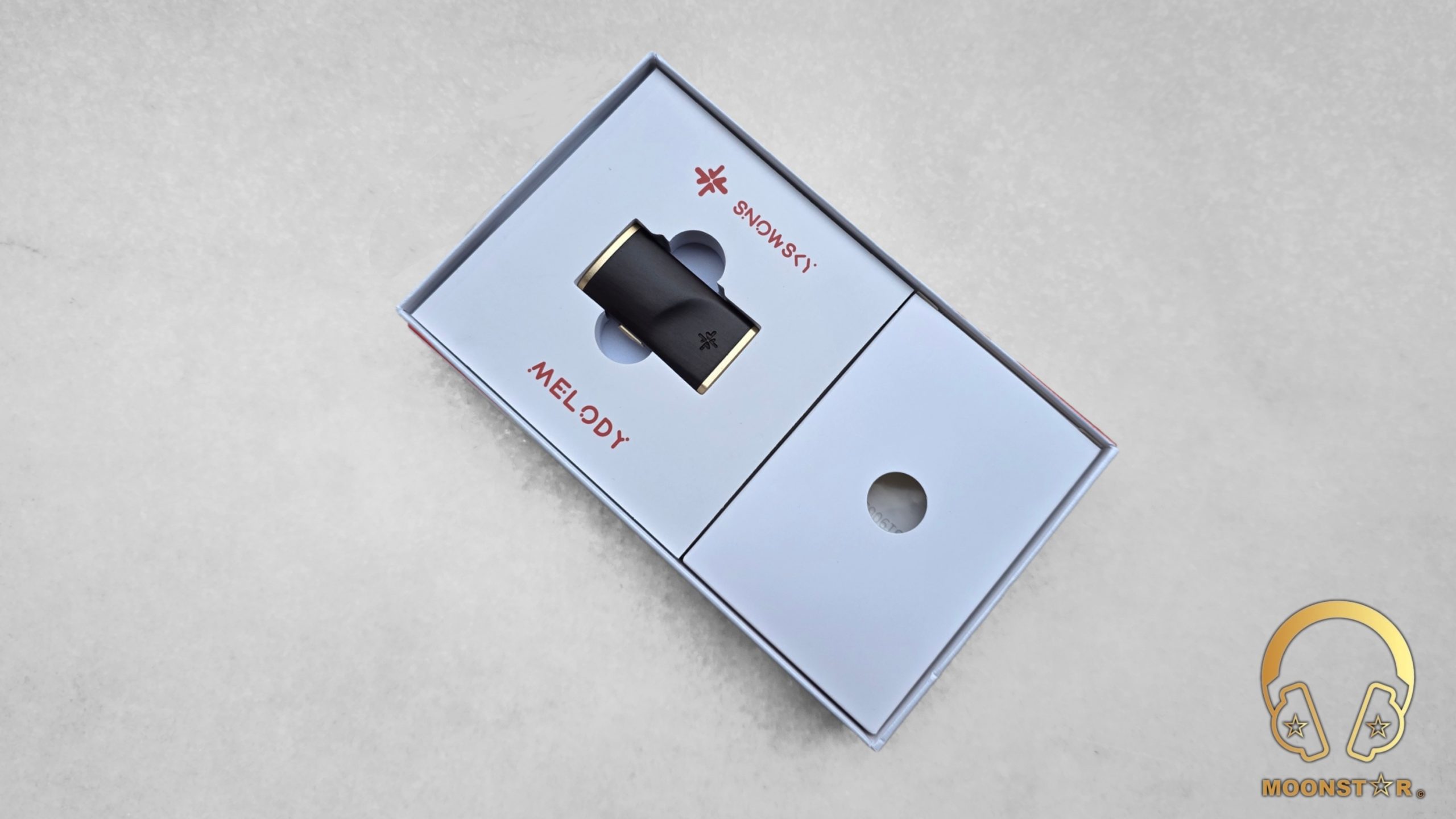
Inside the box, you’ll find:
- 1 x FiiO SNOWSKY Melody USB DAC/AMP
- 1 x A braided USB-C to USB-C cable with gold-plated connectors
- 1 x Quick start guide
- 1 x Warranty card
The included USB-C cable stands out with its braided design in a warm gold hue, complementing the Melody’s aesthetic. Its sturdy build and gold-plated connectors ensure reliable connectivity and minimal signal loss.

Notably, the package does not include a protective case, though an optional faux leather case is available for purchase separately, which looks pretty nice. The unboxing experience is straightforward, focusing on the essentials and aligning with the device’s practical yet refined ethos.

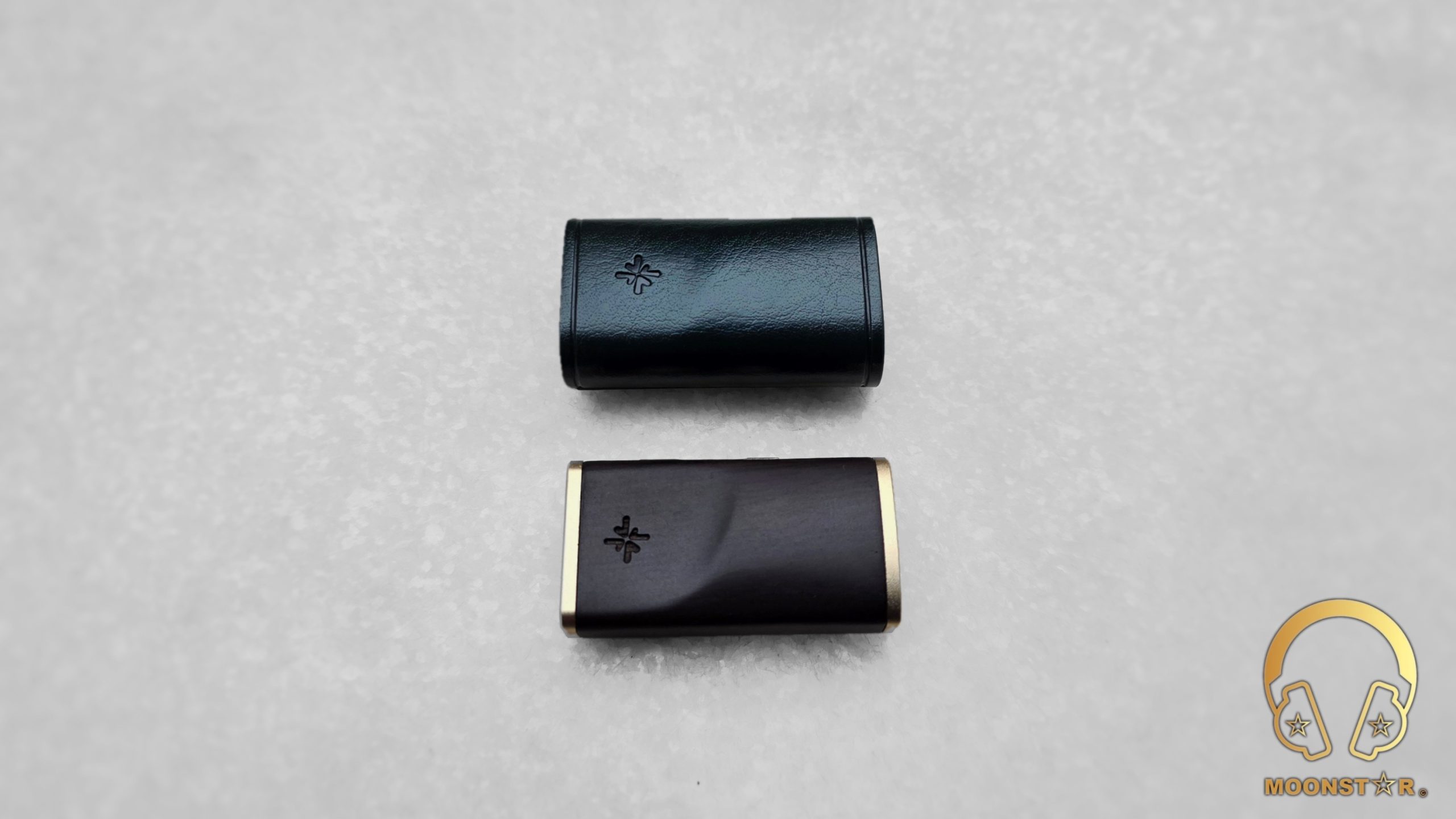
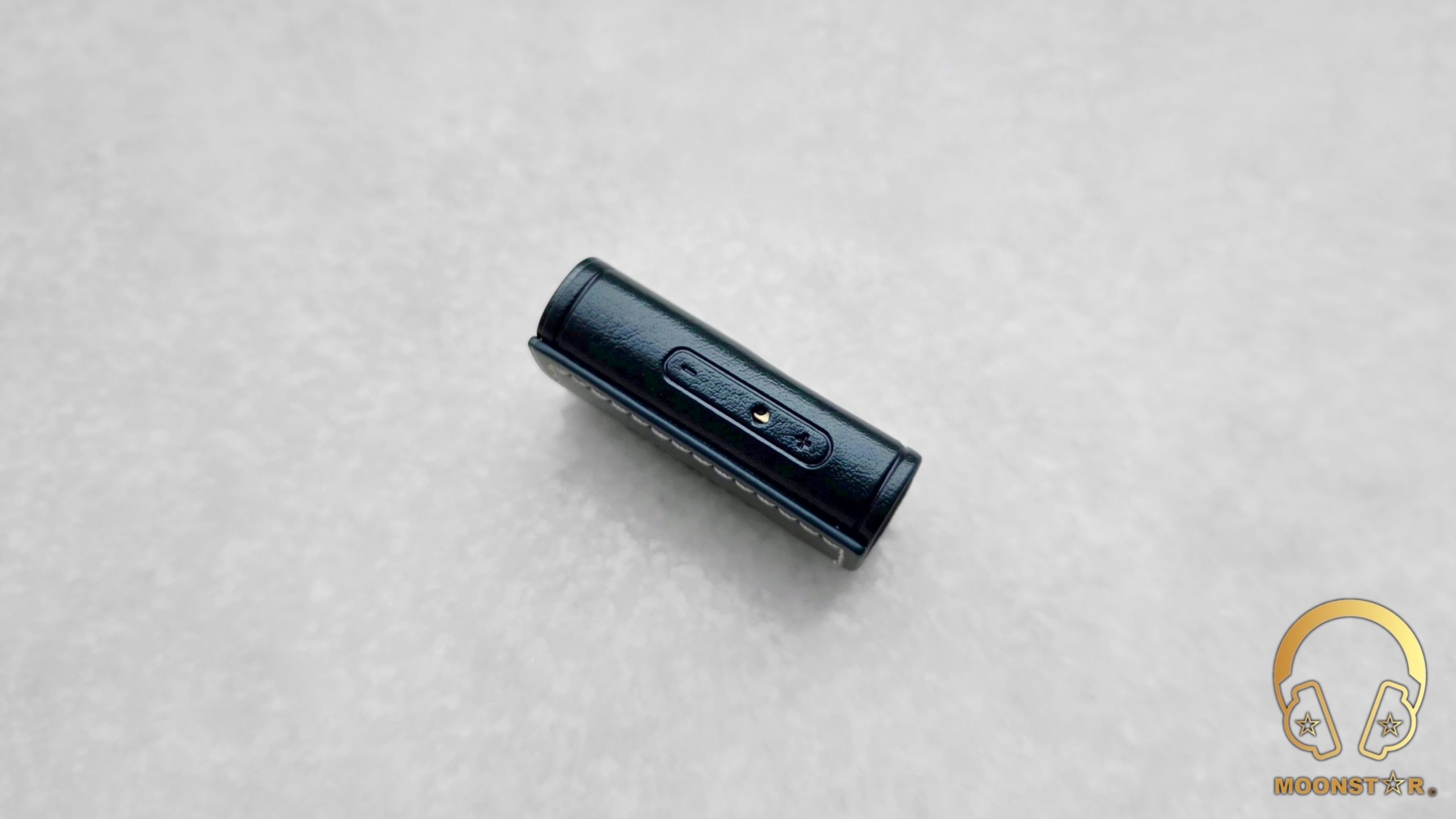
Design & Build Quality:
The FiiO SNOWSKY Melody has a sleek, rectangular shape with a strong, natural finish. It pairs a walnut wood body with gold-colored accents to create a look that feels both premium and understated. This walnut wood version, with its rich, coffee-colored tones and natural grain, brings a warmth and elegance that sets it apart from typical metal or plastic dongles. It measures roughly 42mm long, 22.5mm wide, and 11.5mm thick, and weighs just 10grams. This puts it among the smallest dongle DAC/AMPs I’ve used, boosting its portability without compromising on how it feels in the hand.

The body is crafted from high-quality North American walnut wood with a matte, oiled finish. This is complemented by gold alloy accents around the ports and edges. When I checked the build, I found it to be very sturdy, with no detectable bending or creaking. The natural texture of the wood provides a soft, warm grip that stays comfortable even when I use it for long periods. Because of the unique grain, every unit is slightly different, which I think adds a personal touch. The deep, coffee-like color of the walnut makes it feel more like a finely crafted tool than a tech accessory, improving how it looks and feels.

There are two small, tactile buttons in a contrasting gold color, marked with “+” and “−” symbols for volume control. These offer a precise 60 or 120-step adjustment option via the FiiO Control app, which also supports 10-band EQ and PEQ. The buttons sit flush with the surface, making them easy to use without sticking out awkwardly when connected to a device. They provide satisfying feedback with each press, which makes adjustments intuitive even when I’m moving around.
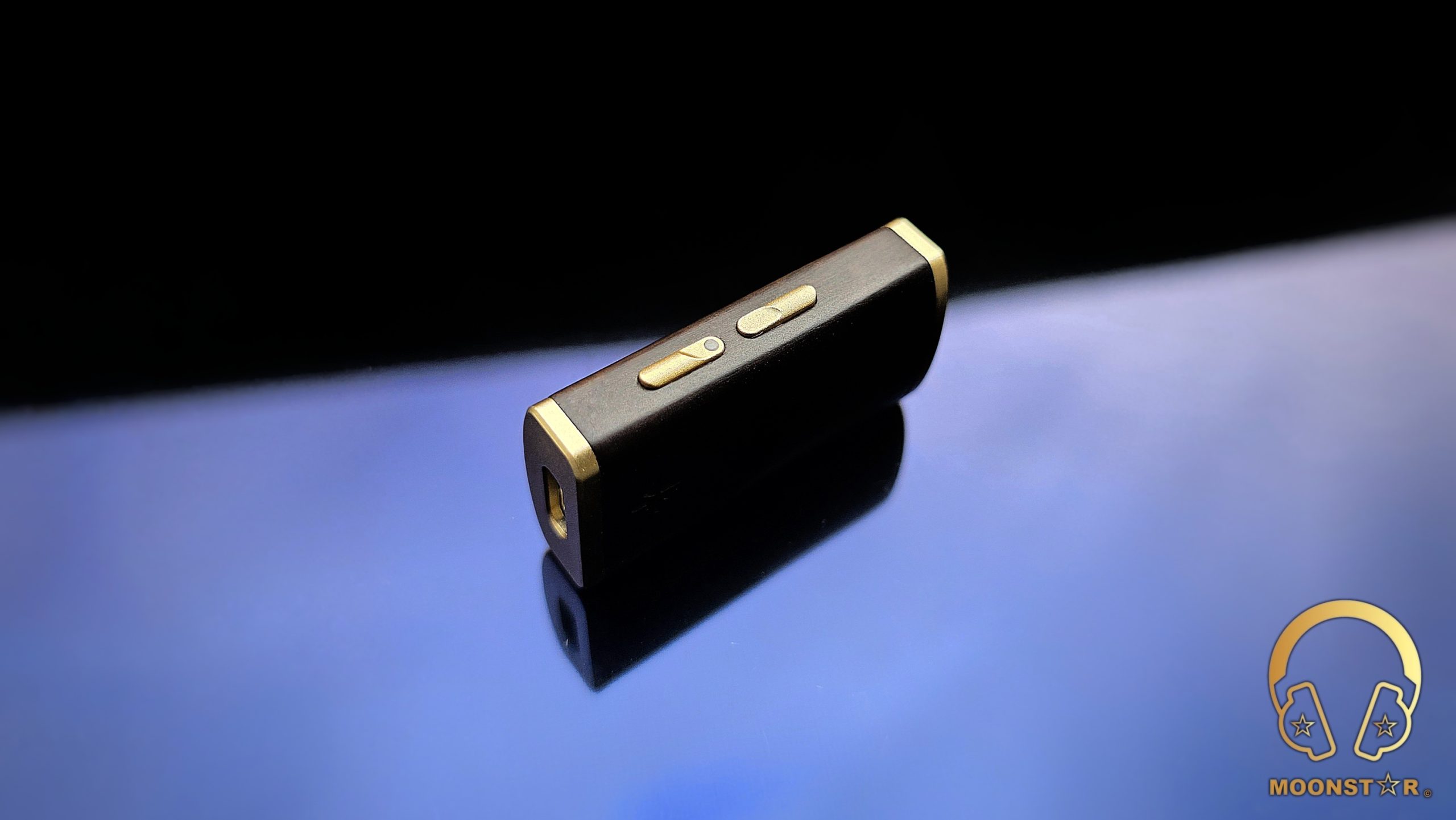
The sides of the device are smooth and featureless, keeping the profile streamlined. The polished edges of the walnut wood ensure there’s no sharp or uncomfortable feeling, making it ergonomic for holding for a long time.
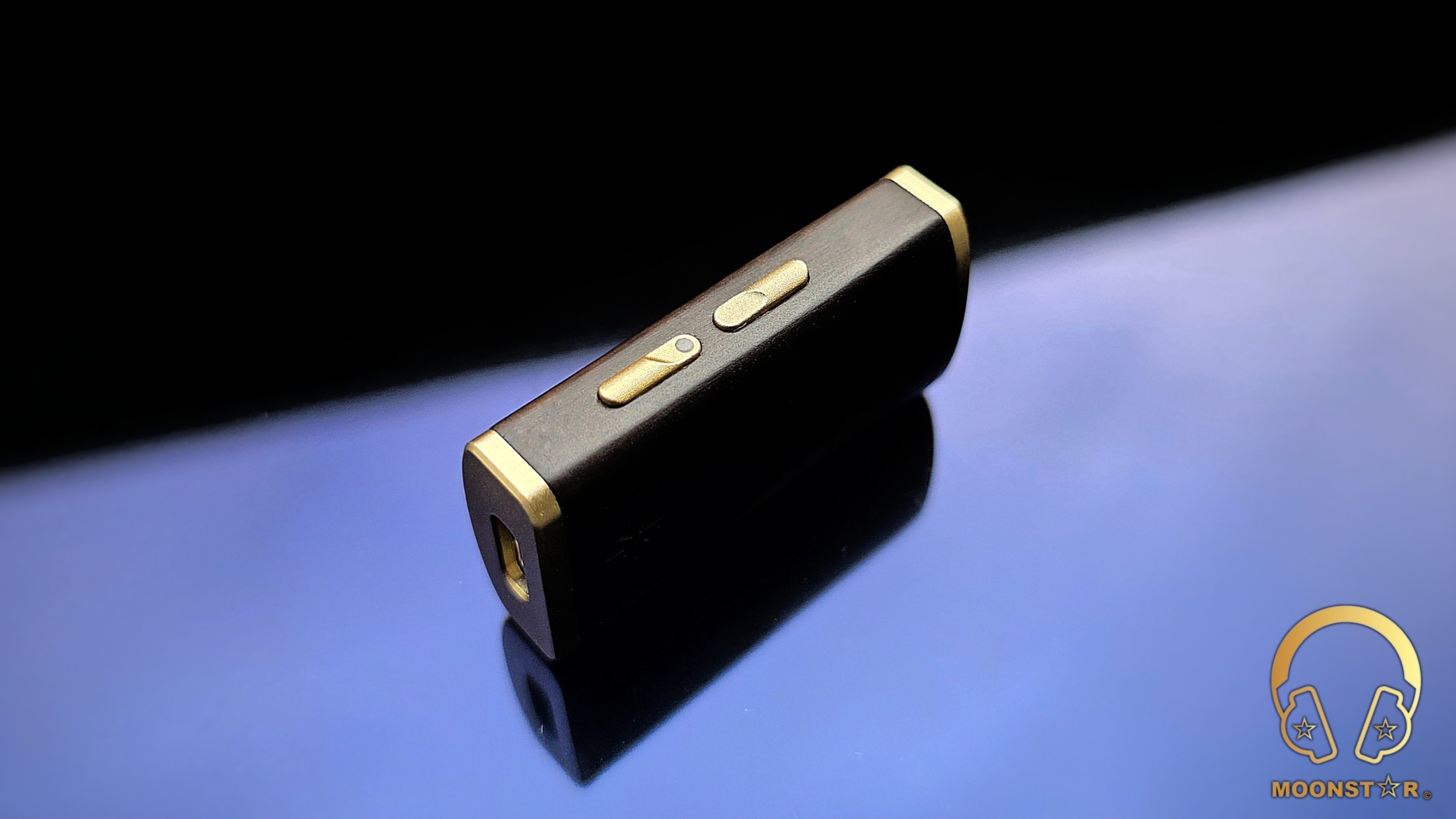
On the bottom, I find the dual headphone outputs: a 3.5mm single-ended jack and a 4.4mm balanced jack. They are placed within recessed, gold-ringed ports, providing a secure connection and a refined look that matches the whole device. The gold accents contrast nicely with the walnut wood, creating a cohesive and appealing appearance.
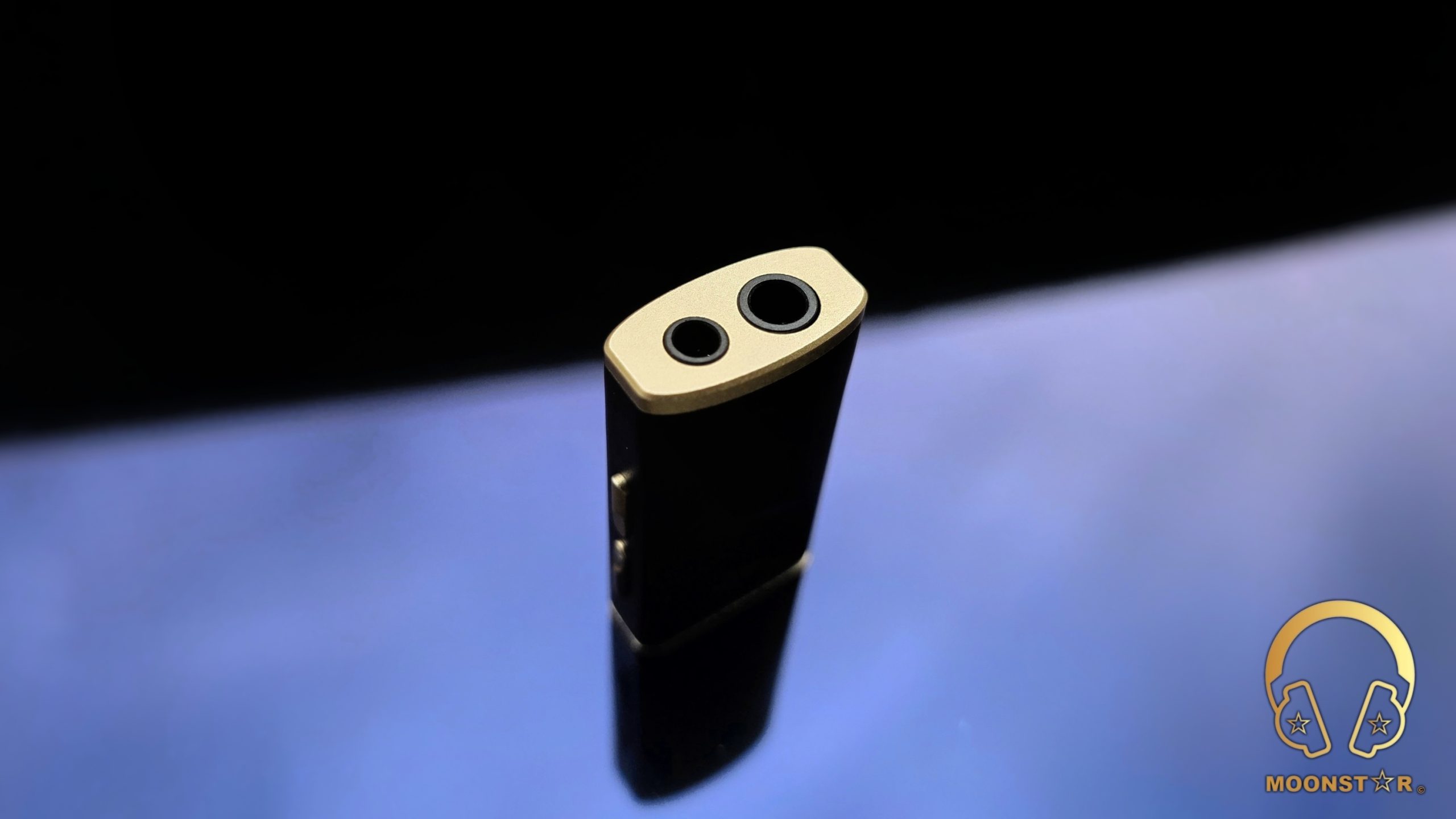
The top surface has the USB-C input port, which is designed to take interchangeable cables for extra flexibility, and it’s finished with a matching gold accent that ties into the wood’s warm colors, ensuring the visual style is consistent across the device.
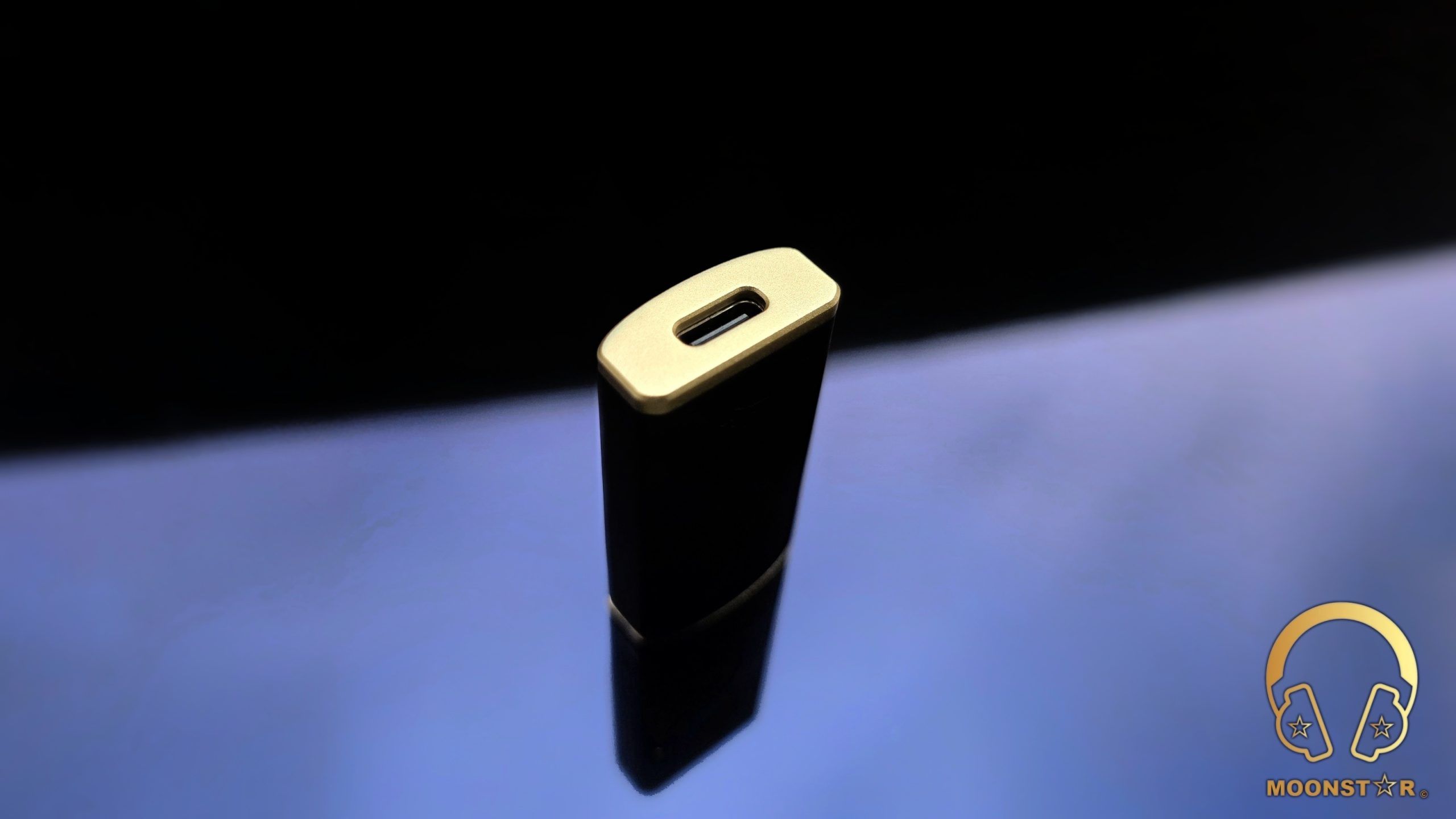
The optional faux leather case, which I tested in a beautiful green color, works well with the walnut wood, boosting protection while adding to the premium feel. It’s custom-fit, wrapping tightly around the Melody with precise cutouts for the ports and buttons, and a small hole for the RGB light. The soft texture and marked button areas on the case make operation easy. The combination of walnut wood and leather gives off a sophisticated, handcrafted vibe that is both visually pleasing and practical for daily carrying.
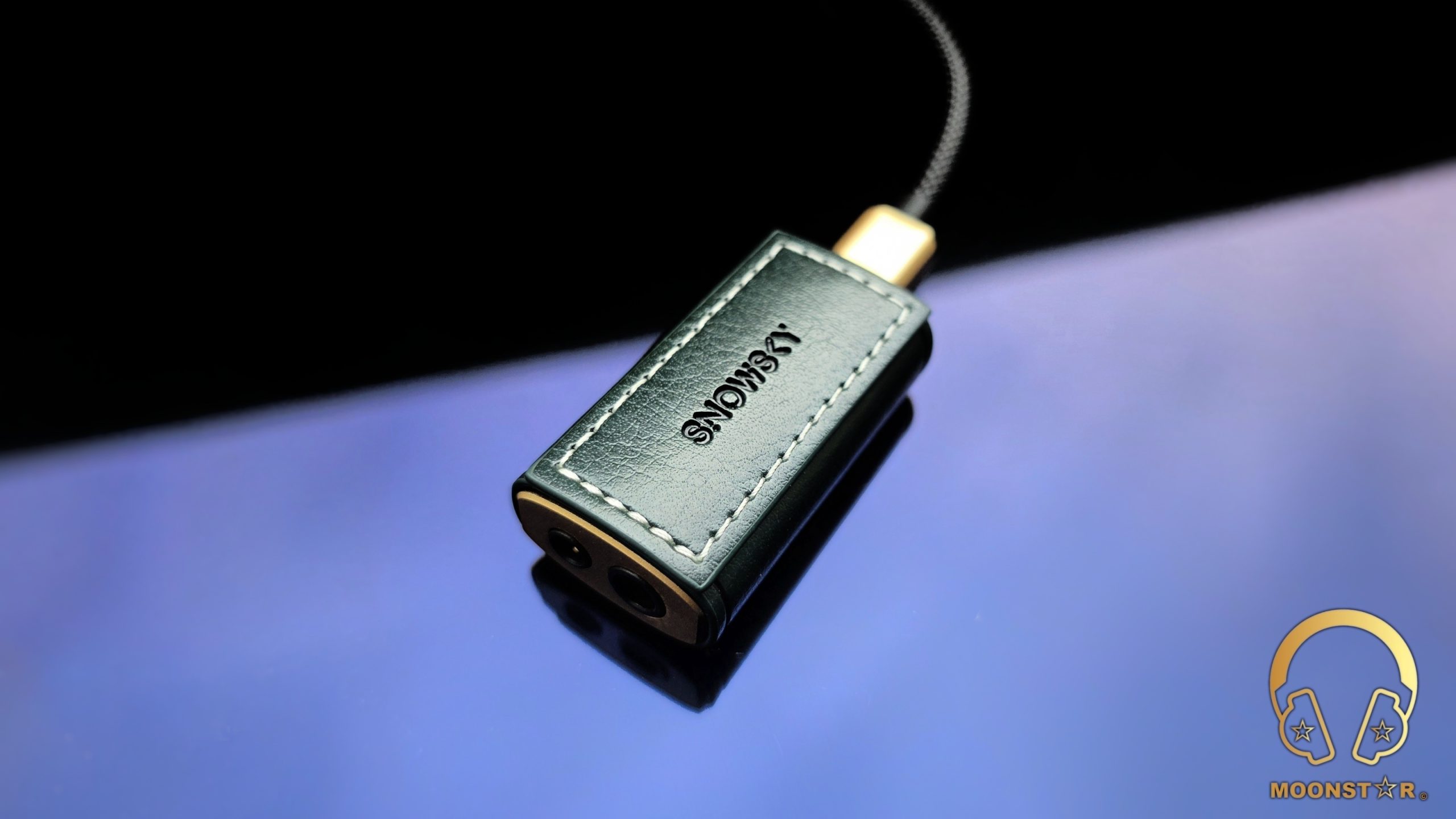
The overall build quality is great, with all the parts fitting together perfectly and a high-quality feel that seems bigger than its compact size. The walnut wood not only helps keep the device light but also helps it handle heat well, keeping the Melody cool even during long, high-resolution playback sessions. This makes it an attractive choice for listeners on the go who value both form and function, as the device stays comfortable in my hand or pocket.
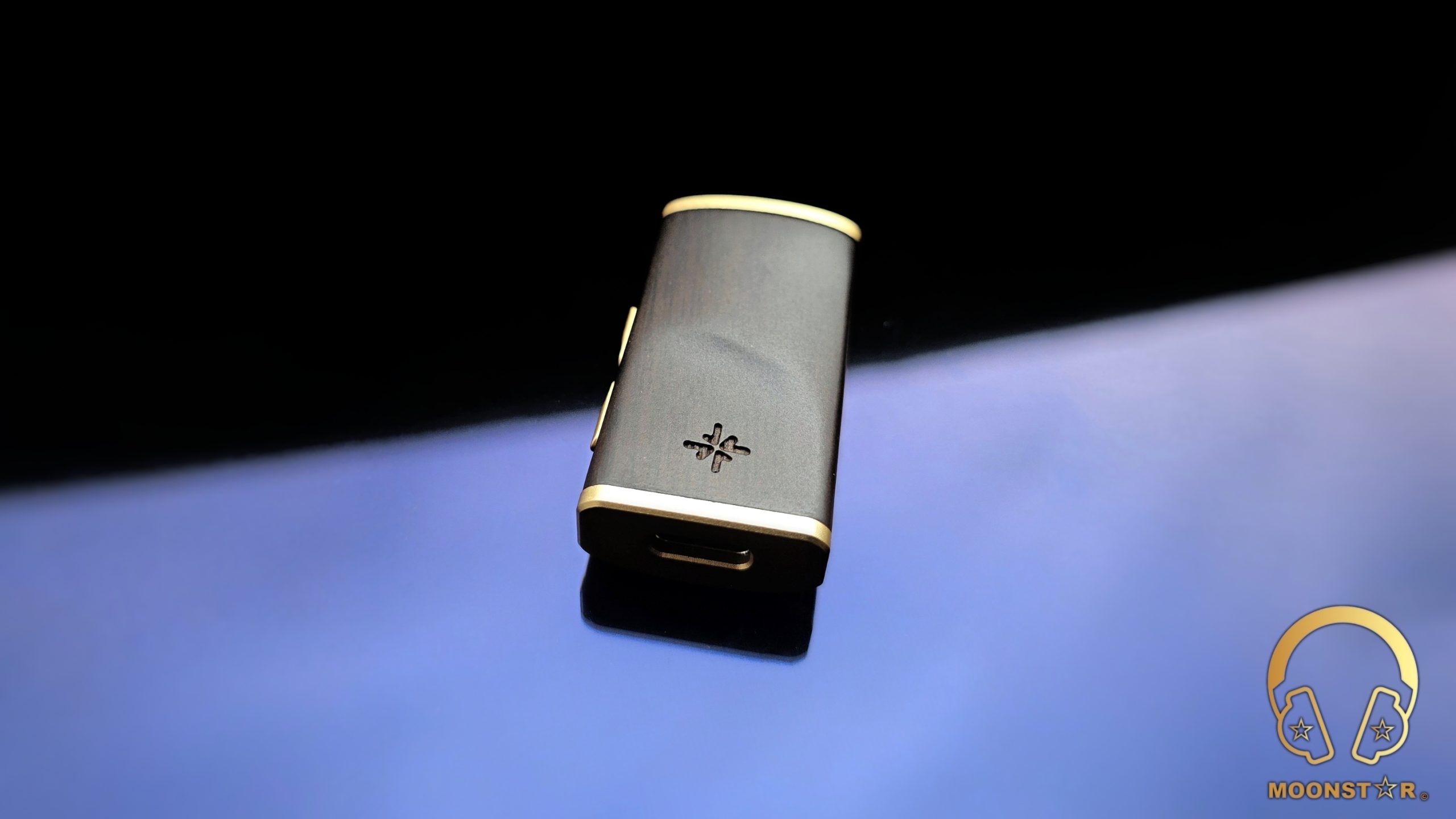
Low Profile Cable:
The included USB-C cable has a high-quality, braided design with gold-plated connectors that match the FiiO SNOWSKY Melody’s look. It’s about 10cm long, which works well for portable use, connecting easily to devices like my Samsung Galaxy Tab S8 Ultra or MSI Vector GP68HX. The cable’s flexibility and durability ensure reliable data and power delivery without adding unnecessary bulk. I can also choose to use different cables, like ones with L-shaped connectors, if I needed a better setup for specific uses, further extending the device’s usefulness.
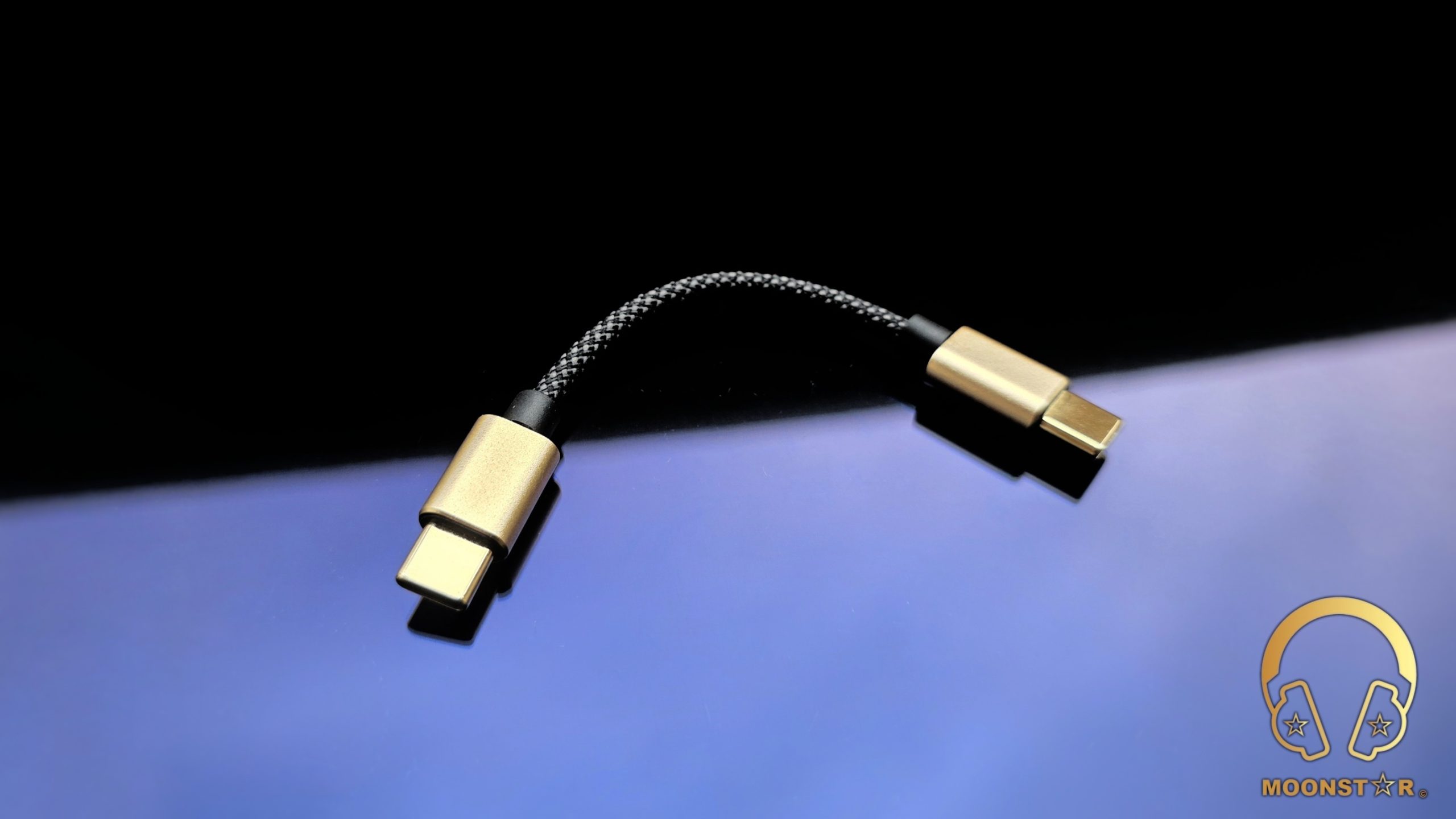
FiiO QX13 – Technical Overview:
- Model: SNOWSKY Melody
- DAC Chips: Dual Cirrus Logic CS43131 chips
- USB chip: SPV5048
- Output Power: 100mW @ 32Ω – 3.5mm SE / 250mW @ 32Ω – 4.4mm BAL
- Output Voltage: 2.3V (3.5mm SE), 4V (4.4mm BAL) at 32Ω
- Supported Audio Formats: PCM up to 32-bit/384kHz; DSD64, DSD128, DSD256
- Frequency Response: 20Hz–20kHz (±0.1dB), 20Hz–50kHz (±0.2dB)
- Signal-to-Noise Ratio: ≥123dB (3.5mm SE), ≥127dB (4.4mm BAL)
- THD+N: <0.00066% (3.5mm SE), <0.0003% (4.4mm BAL)
- Connectivity: USB-C input with OTG support; compatible with Android, iOS, Windows, macOS, and gaming consoles (UAC 1.0 mode)
- Dimensions and Weight: 42 x 22.5 x 11.5 mm; 10g
- Additional Features: FiiO Control app support with 10-band EQ and PEQ, SPDIF/coaxial output via 3.5mm, UAC 1.0/2.0 modes, 60/120-step volume control
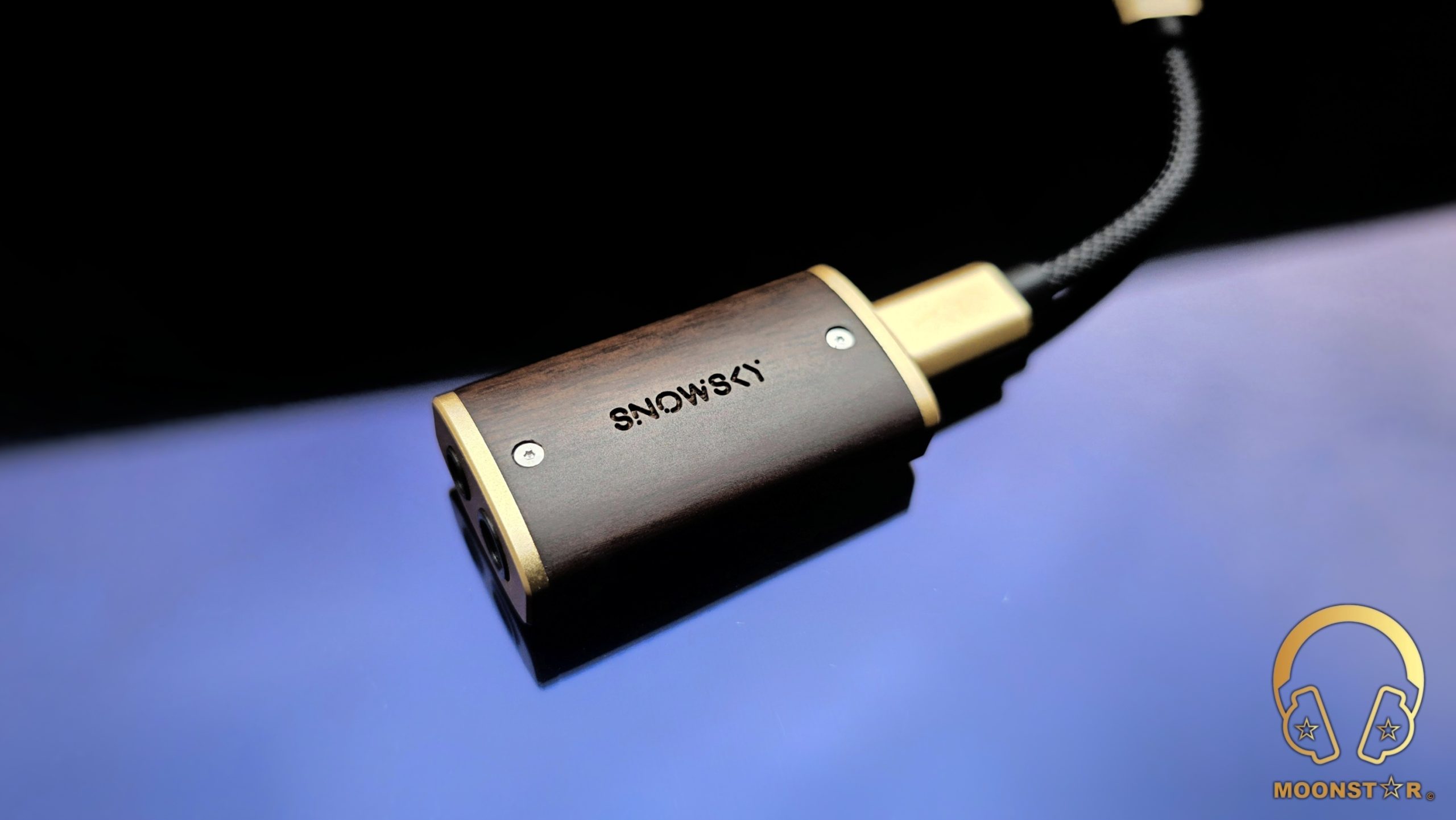
Hardware & Softwear Features:
DAC & Amplification:
The FiiO SNOWSKY Melody is powered by dual Cirrus Logic CS43131 DAC chips, known for their low distortion and high dynamic range, paired with an efficient amplification stage that delivers clean, powerful output. The dual-DAC setup ensures excellent channel separation, enhancing stereo imaging and detail retrieval. With support for high-resolution PCM and native DSD formats, the Melody handles demanding audio files with ease, making it suitable for audiophile-grade libraries.

Volume and Gain Controls:
The Melody features a precise 60 or 120-step volume control, which I can adjust using the FiiO Control app. The app supports both 10-band EQ and PEQ, letting me make fine-tuned adjustments without depending on the source device’s volume. The physical volume buttons offer quick feedback, and the app lets me switch between gain modes (low/high) to suit various headphones and IEMs. The RGB indicator gives clear visual cues for the sampling rates.
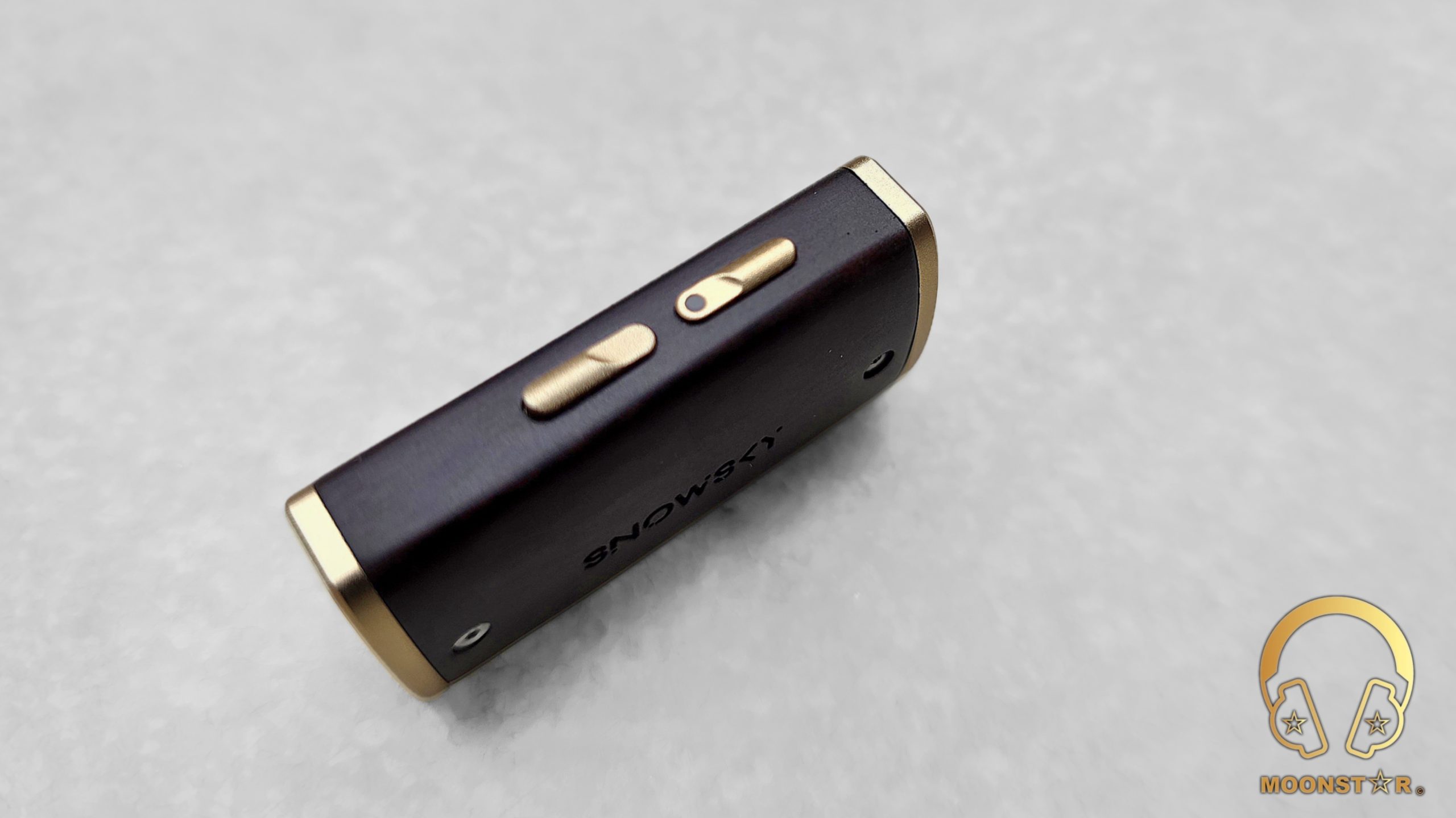
Connectivity & Audio Support:
The USB-C interface supports plug-and-play functionality across multiple platforms, including smartphones, tablets, PCs, and gaming consoles (via UAC 1.0 mode). The 3.5mm port supports SPDIF and coaxial outputs with an adapter, adding versatility for integration with external audio systems. The device also supports in-line microphone and control functionality, making it practical for calls and multimedia use.
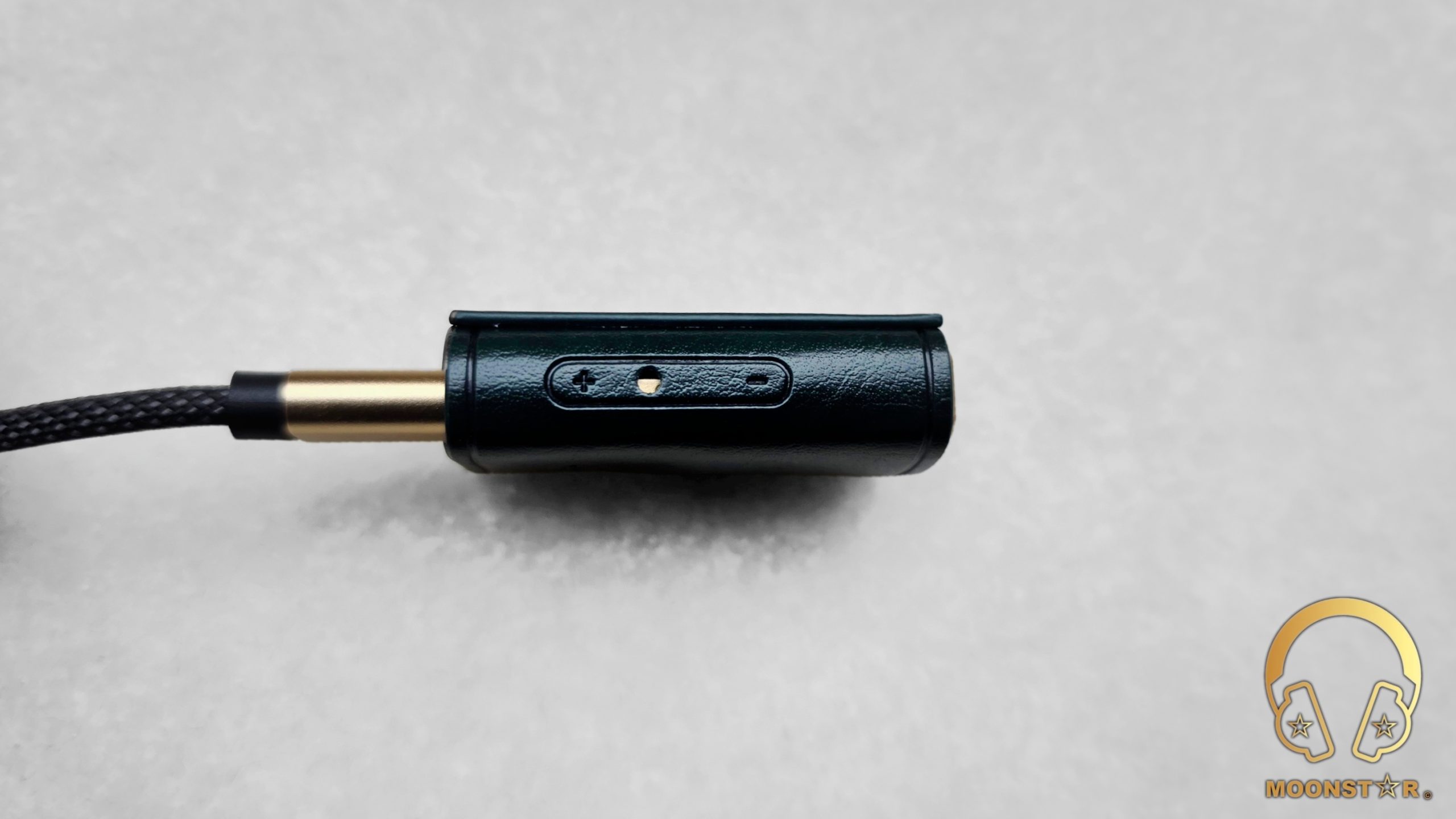
Battery Impact:
The Melody is designed for efficiency, drawing minimal power from the source device. During testing, it maintained reasonable battery consumption, allowing for extended listening sessions on smartphones without significant drain, even when playing high-resolution files continuously for over six hours. High-gain mode slightly increases power usage, but the overall impact remains manageable, with a typical drain of less than 5% per hour on a fully charged device like the Samsung Galaxy Tab S8 Ultra. This efficiency makes it suitable for on-the-go use, and the device supports USB power delivery to further reduce battery strain when connected to compatible sources, ensuring prolonged playback without frequent recharging.
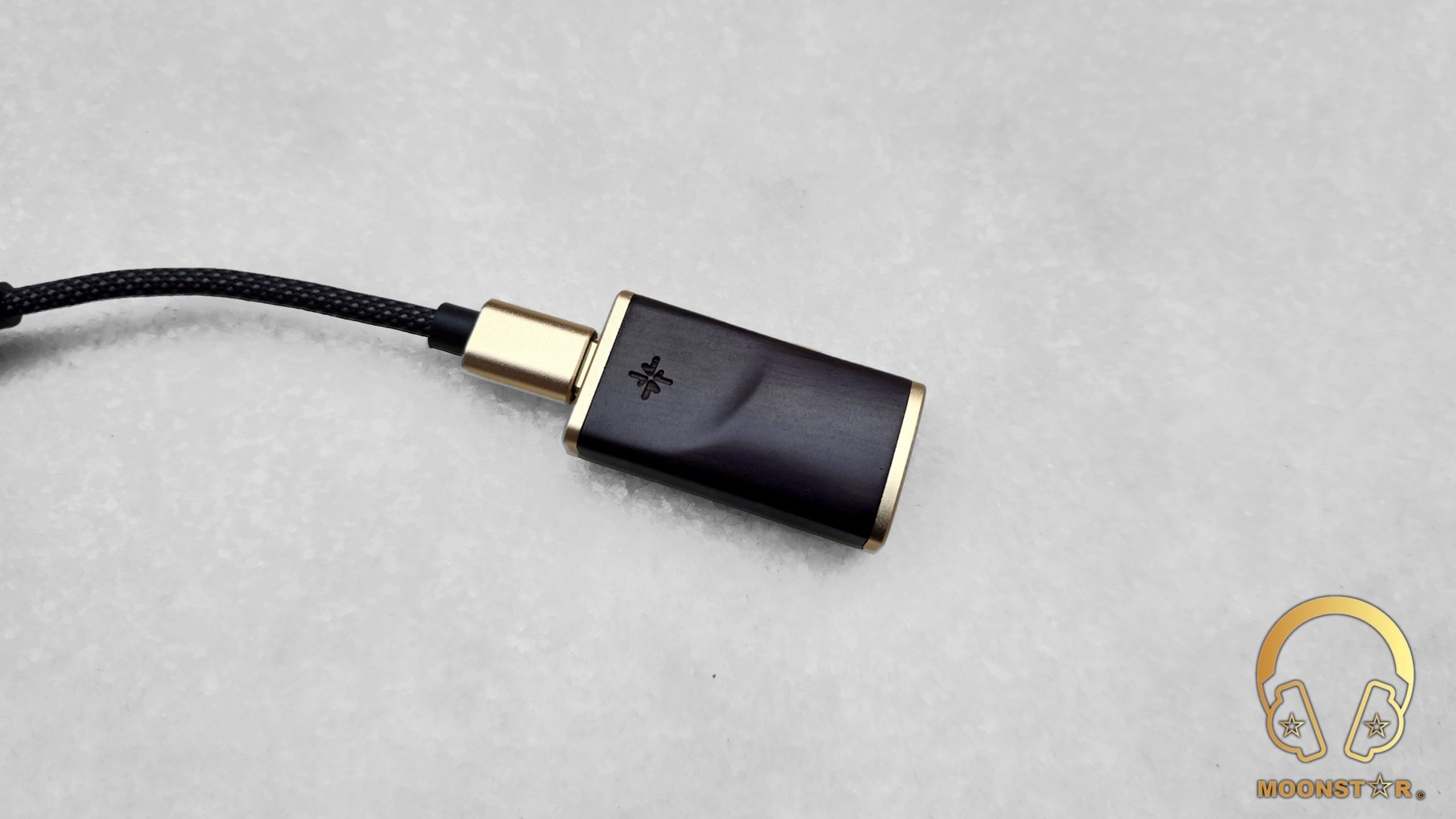
FiiO Control App:
The FiiO SNOWSKY Melody integrates seamlessly with the FiiO Control app, offering users extensive customization options to personalize their listening experience. The app’s built-in advanced DSP enables a 10-band high-precision PEQ, allowing for precise adjustments to tailor the sound signature to individual preferences. In addition to the built-in PEQ presets, there are three custom PEQ profiles that users can freely adjust, empowering you to become the master tuner of your sound.

The Melody also supports the FiiO Control app and web link control, through which PEQ settings can be saved and shared, adding some fun with others. Due to system permission restrictions, iOS devices cannot connect to or control the Melody via the FiiO Control app. This feature set makes the app a powerful tool for Android and web users, enabling detailed sound shaping that enhances the device’s versatility without compromising its plug-and-play simplicity.
Equipment’s used for this review:
- DACs: FiiO SNOWSKY Melody, Hidizs S8 Pro Robin
- Source Devices: Samsung Galaxy Tab S8 Ultra, MSI Vector GP68HX
- IEMs: FiiO FP3, FiiO FD11
- Cables: Stock braided USB-C cable (included with Melody)
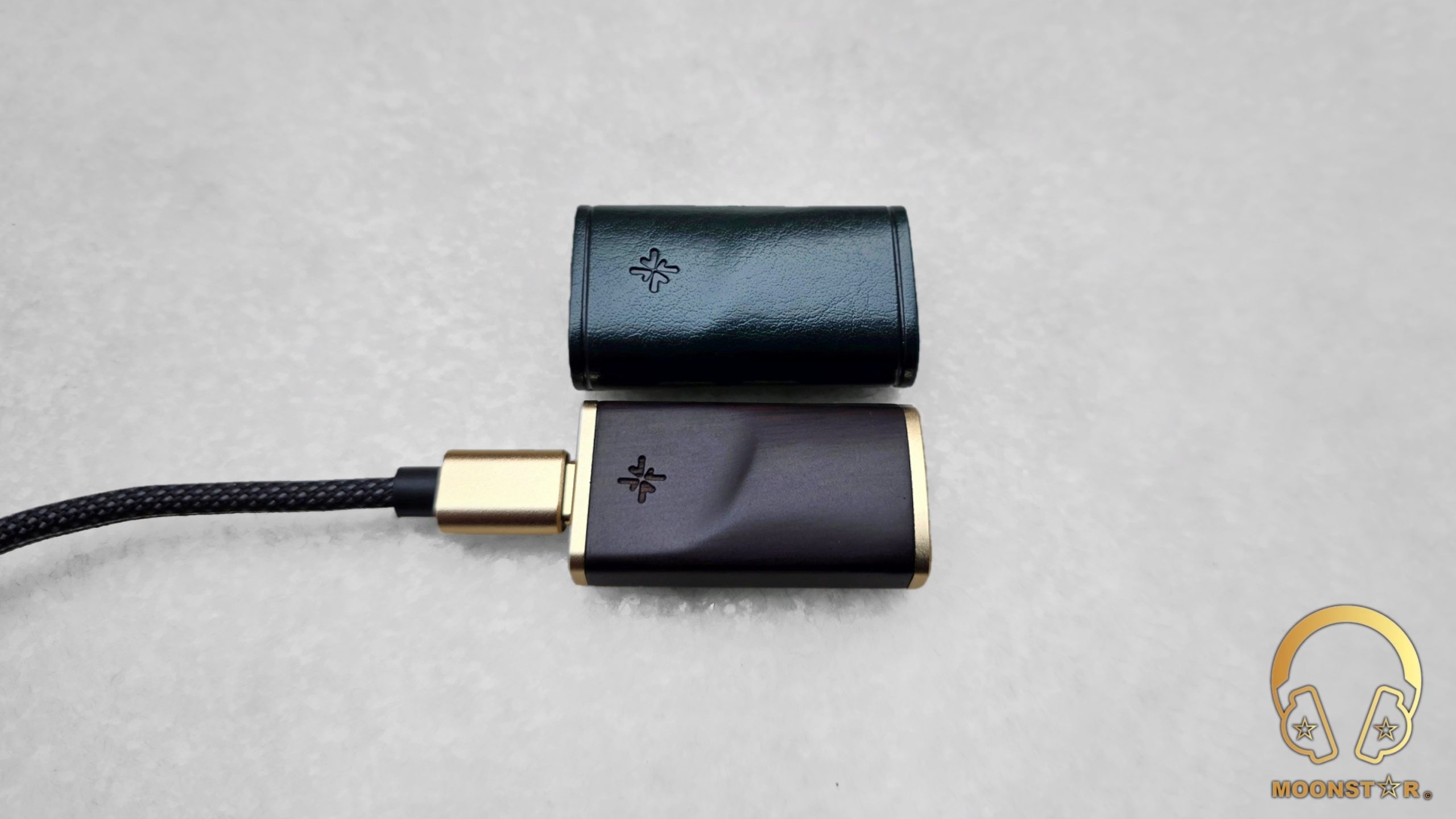
Albums & Tracks Used for this Review:
Vocal Jazz / Smooth Jazz
- Norah Jones – Come Away With Me (Flac 24bit/96kHz)
- Diana Krall – So Wonderful (DSF)
- Barry White – Just The Way You Are (Flac 24bit/48kHz)
- Isaac Hayes – Walk On By (Flac 16bit/44.1kHz)
- Sting – Englishman in New York (Flac 24bit/48kHz)
- Otto Liebert & Luna Negra – The River (Flac 24bit/192kHz)
- Ferit Odman – Look, Stop & Listen (Flac 24bit/192kHz)
- Charly Antolini – Duwadjuwandadu (Flac 24bit/192kHz)
Soul / R&B
- Aretha Franklin – I Say A Little Prayer (Flac 24bit/96kHz)
- Adele – My Little Love (Apple Lossless)
- George Michael – Don’t Let the Sun Go Down on Me (Flac 24bit/192kHz)
- Eric Clapton – Wonderful Tonight (Flac 24bit/96kHz)
Pop / Rock Classics
- Michael Jackson – Billie Jean (Flac 24bit/96kHz)
- Elton John – Rocket Man (Flac 24bit/96kHz)
- David Bowie – Heroes (Flac 24bit/192kHz)
- U2 – Sunday Bloody Sunday (Flac 16bit/44.1kHz)
- Lorde – Royals (Flac 24bit/48kHz)
- Dave Gahan – Kingdom (Apple Lossless)
Electronic / Experimental
- Daft Punk – Instant Crush (Flac 24bit/96kHz)
- Daft Punk – Doin’ it Right (Flac 24bit/96kHz)
- Bro Safari, UFO! – Drama (Apple Lossless)
- Armin Van Buuren – Vini Vici (Flac 16bit/44.1kHz)
- Yosi Horikawa – Bubbles (Apple Lossless)
- Toutant – Rebirth (Apple Lossless)
Alternative / Indie / Art Rock
- Radiohead – Live in Berlin “Album” (Apple Lossless)
- Radiohead – Pyramid Song (Apple Lossless)
- Muse – Hysteria (Flac 24bit/96kHz)
- Red Hot Chili Peppers – Nobody Weird Like Me (Flac 24bit/48kHz)
- Lunatic Soul – The Passage (Flac 16bit/44.1kHz)
- Portishead – It Could Be Sweet (Apple Lossless)
- Gogo Penguin – Raven (Flac 24bit/192kHz)
- Gogo Penguin – Murmuration (Flac 24bit/192kHz)
- Massive Attack – Angel (Flac 24bit/48kHz)
- Bear McCreary – Valkyries (Apple Lossless)
Classical / Orchestral
- Max Richter – On the Nature of Daylight (Flac 24bit/96kHz)
- Chopin – Nocturne No. 20 in C-Sharp Minor (Flac 16bit/44.1kHz)
- Clair de Lune – Claude Debussy (Apple Lossless)
- Tchaikovsky – Symphony No. 5 (Flac 16bit/44.1kHz)
- Vivaldi – Le Quattro Stagioni “The Four Seasons” (Apple Lossless)
- Fazıl Say – Nazım Oratoryosu (Live) (Flac 16bit/44.1kHz)
Jazz / Instrumental
- Miles Davis – So What (Apple Lossless)
World / Traditional
- Sertap Erener – Aşk (Flac 16bit/44.1kHz)
- Edith Piaf – Non Je Ne Regrette Rien (Flac 16bit/44.1kHz)
Metal / Progressive Rock
- Metallica – Dyers Eve (Flac 24bit/96kHz)
- Metallica – Sad but True (Flac 24bit/96kHz)
- Megadeth – Sweating Bullets (Apple Lossless)
- Opeth – Windowpane (Flac 16bit/44.1kHz)
- Deftones – My Own Summer (Shove It) (Flac 16bit/44.1kHz)
- Rush – Tom Sawyer (Flac 16bit/44.1kHz)
- Slayer – Angel of Death (Apple Lossless)
- Liquid Tension Experiment 2 – Acid Rain (Apple Lossless)
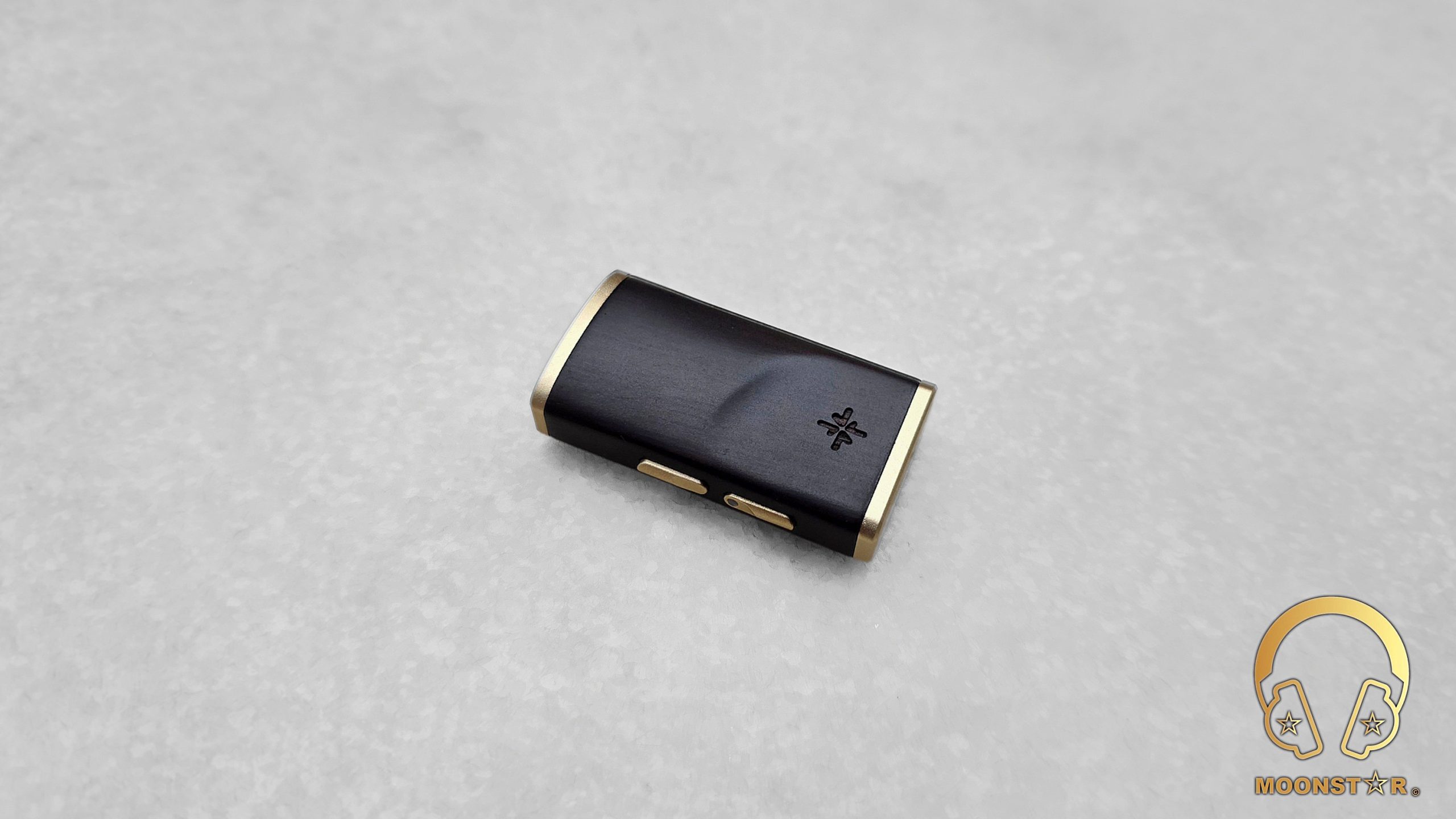
The Sound:
The FiiO SNOWSKY Melody presents a generally neutral sound profile with a subtle degree of warmth, emphasizing sonic accuracy. It offers an uncolored representation of the audio source with minimal evident frequency emphasis. This neutral presentation facilitates the distinct characteristics of connected IEMs, such as the FiiO FP3 and FiiO FD11, to be clearly perceived, making it suitable for attentive listening where fidelity to the source is prioritized.
The Melody’s sonic performance is noteworthy considering its price point of $39.99, exceeding typical expectations for an entry-level device. While it operates within the budget category and does not compete with high-end audio equipment, its output represents a clear performance upgrade over standard integrated phone audio. Its sound quality is competitive with dongle DACs at higher price tiers.
Across extended listening tests, the device demonstrated consistent performance across various musical genres, handling complex mixes without introducing audible artifacts. The balanced 4.4mm output appears to contribute to enhanced stereo separation and dynamic range, while the 3.5mm single-ended port yields a slightly more immediate soundstage. Both outputs maintain consistent frequency response integrity, offering an engaging yet manageable listening experience over extended periods.
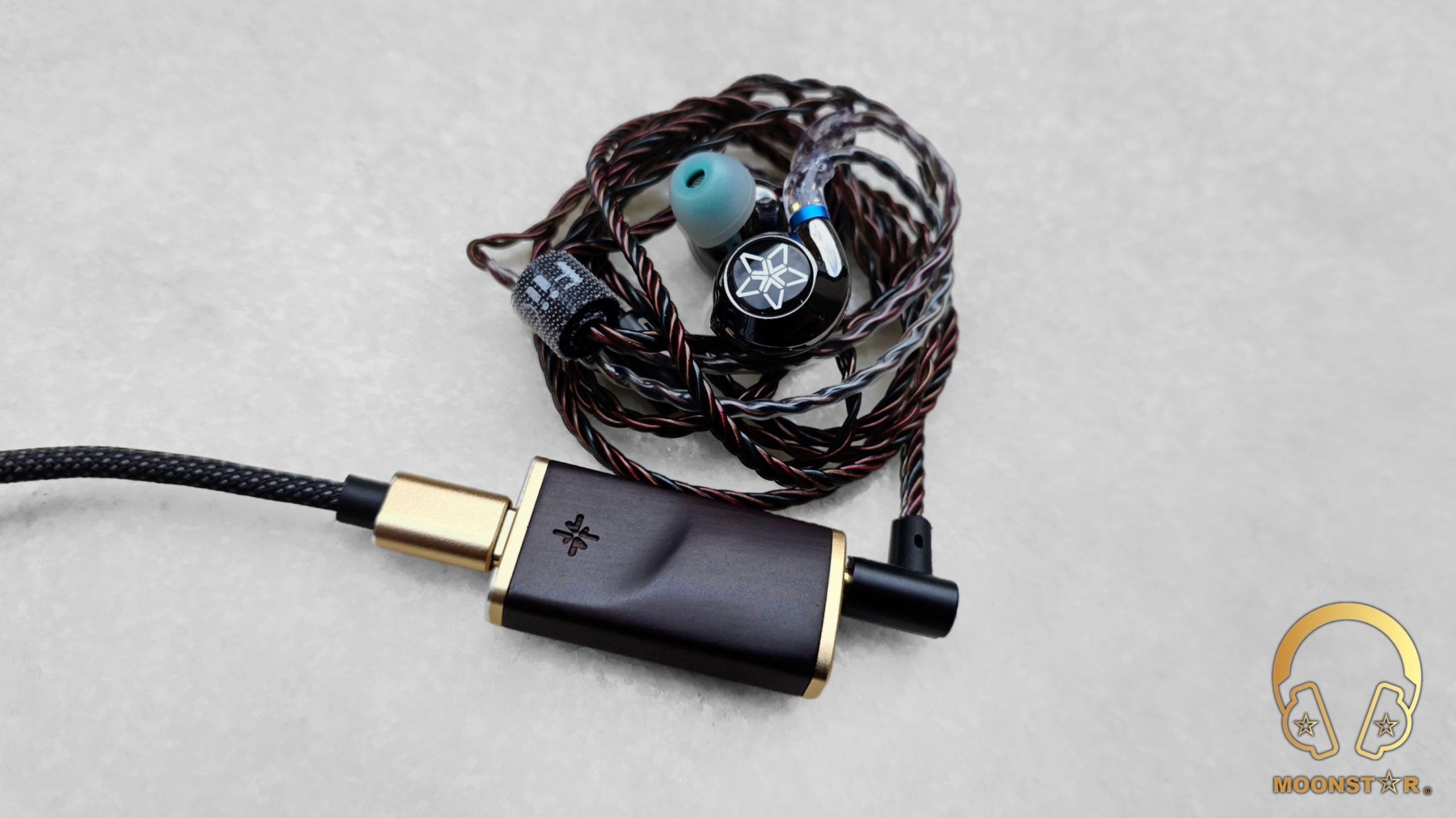
Bass:
The bass response is characterized by control and articulation, with discernible extension into the sub-bass region, avoiding excessive bloom or congestion. In tracks featuring deep electronic bass lines, such as Bro Safari and UFO!’s “Drama,” the device maintained rhythmic precision, preserving transient clarity. Mid-bass presence is adequate but reserved, ensuring it does not overshadow other elements. This is demonstrated by the defined and integrated kick drum and bass lines in Metallica’s “Sad But True.”
For IEMs with a naturally modest low-end, this neutral presentation can highlight inherent deficiencies; however, with balanced setups like the FiiO FP3, which exhibits a subtle low-end roll-off, it provides a solid foundation, avoiding exaggeration, as noted on Megadeth’s “Sweating Bullets,” where the bass riff’s texture is evident. When paired with the FiiO FD11, known for its tuned bass response, the Melody conveys sub-bass presence in demanding tracks like Armin Van Buuren’s “Vini Vici,” maintaining clarity in complex arrangements. The bass handling appears realistic, with accurate rendering of decay and texture, heard in Michael Jackson’s “Billie Jean,” and in Really Slow Motion’s “Deadwood,” where the low-end adds mass without overwhelming orchestral components.
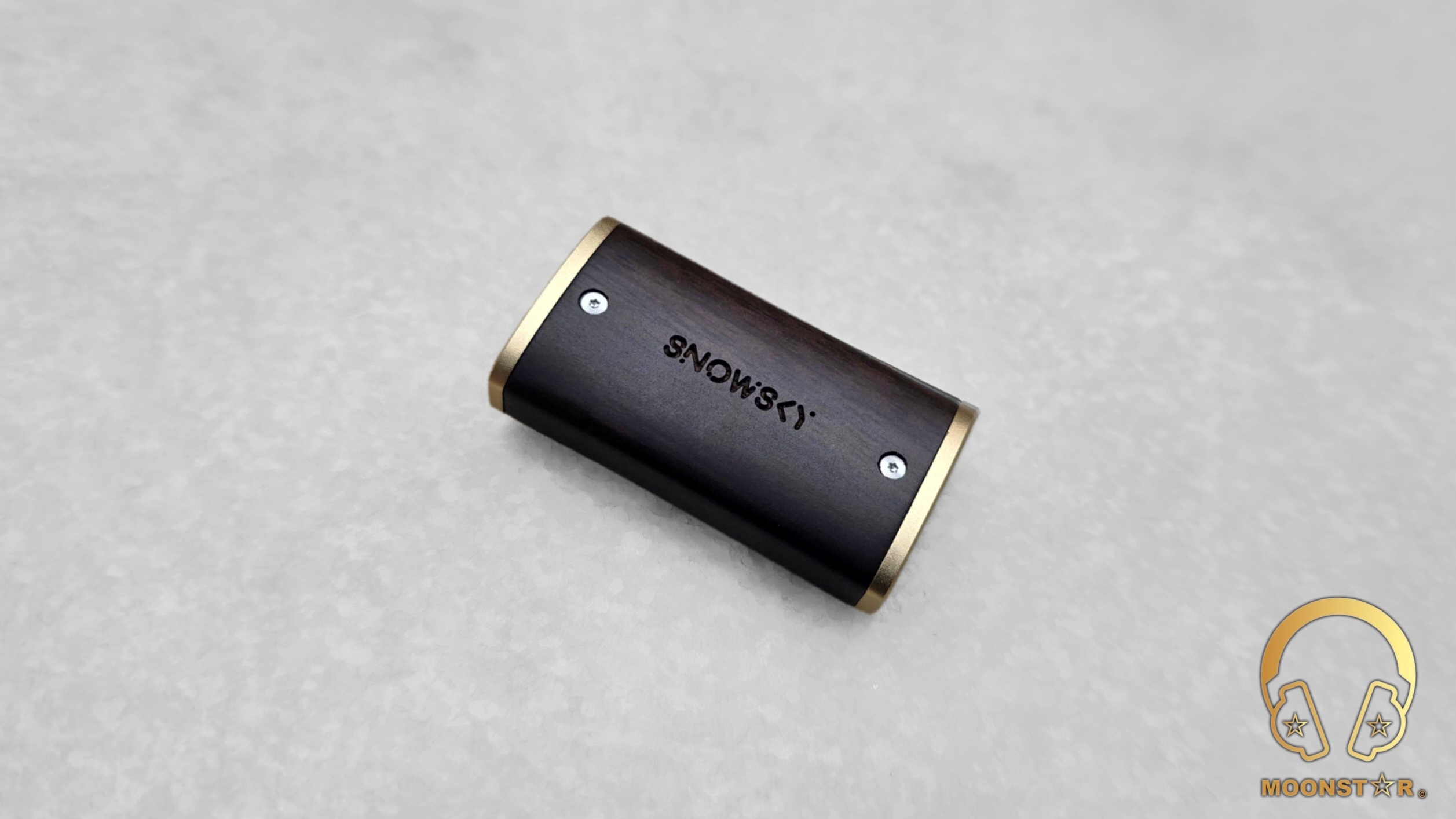
Midrange:
The midrange is rendered with clarity and natural tonal qualities, allowing vocals and instruments to sound realistic. The presentation is even across the range, without noticeable forwardness or recession. Guitar tones retain textural detail, and piano notes exhibit appropriate decay, as observed in Elton John’s “Rocket Man,” where the piano’s resonance and vocal inflections are conveyed with detail. The overall midrange tuning mitigates harshness, contributing to listener comfort during long sessions, especially evident in vocal-focused tracks like David Bowie’s “Heroes,” where subtle vocal and instrumental details are conveyed with clarity.
Paired with the FiiO FP3, the midrange acquires a slight airiness that appears to improve instrument separation on Eric Clapton’s “Wonderful Tonight.” The FiiO FD11 adds a slight warmth to vocals without significantly compromising neutrality, creating an immersive acoustic feel, as in Sarah McLachlan’s “Angel,” where emotional and subtle harmonic nuances are maintained. This frequency segment benefits from the device’s low distortion, supporting faithful reproduction of harmonic overtones, resulting in a cohesive sound. This is apparent in Sting’s “Englishman in New York,” and in Sertap Erener’s “Aşk,” where vocal articulation is clear.
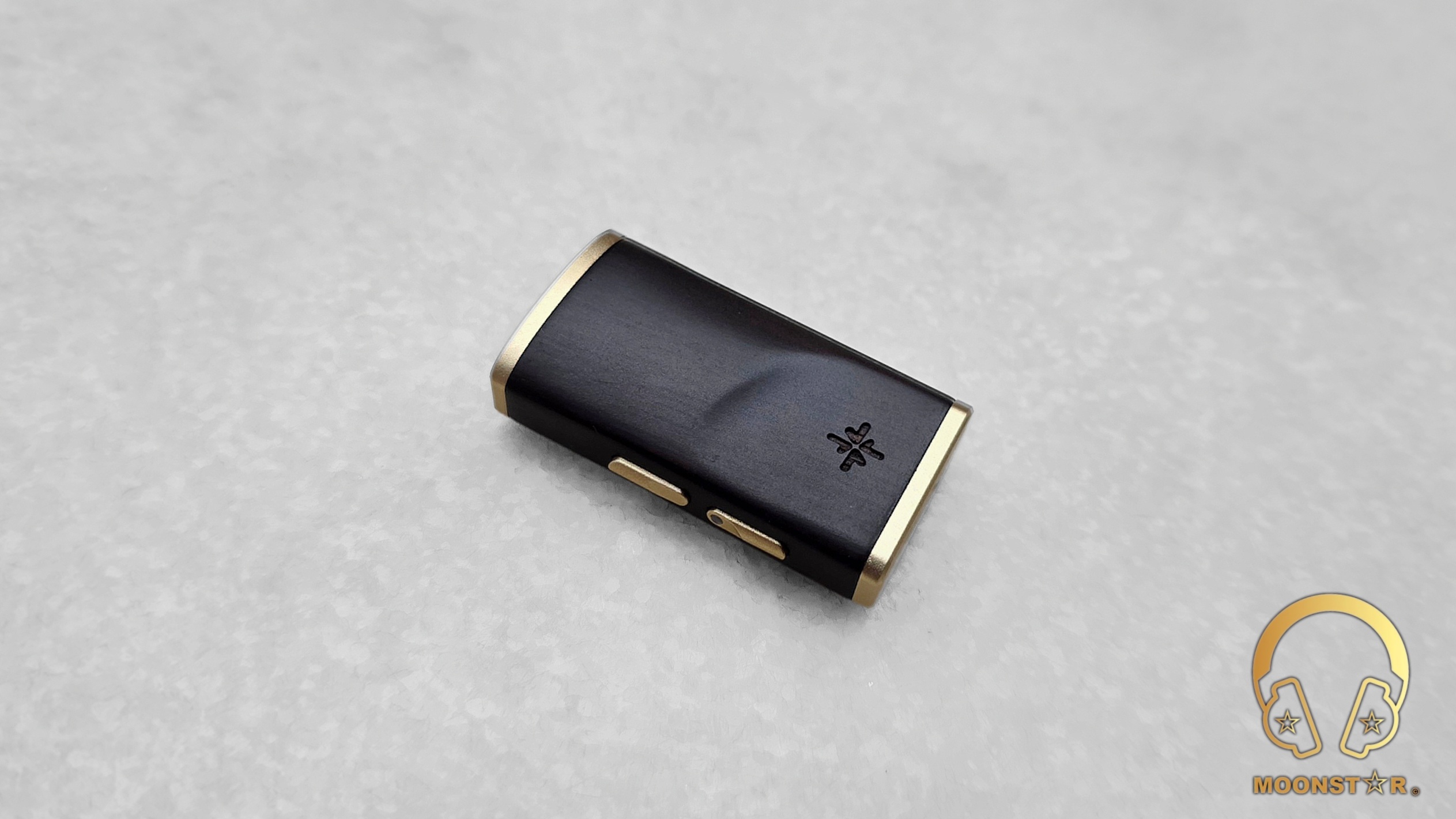
Treble:
Treble extension is smooth and detailed, offering notable airiness without excessive sibilance. High-frequency details and cymbals emerge cleanly, supporting complex compositions like the strings in Vivaldi’s “Le Quattro Stagioni,” where violins are lively yet controlled. The upper register maintains composure to minimize listener fatigue, even on brighter recordings, exemplified by the crisp, controlled high notes in Otto Liebert & Luna Negra’s “The River,” where the natural decay of guitar strings is preserved.
When paired with the FiiO FP3, the treble appears refined, accentuating micro-details in ambient sounds on Gogo Penguin’s “Raven.” The FiiO FD11 seems to moderate potential brightness, promoting a balanced presentation suitable for extended classical or jazz listening, such as Diana Krall’s “So Wonderful,” where piano highs and cymbals maintain detail without glare. This controlled high-frequency approach contributes to an overall sense of openness, potentially aiding in the perception of spatial cues in recordings, as in Charly Antolini’s “Duwadjuwandadu,” and in Ferit Odman’s “Look, Stop & Listen,” where the cymbal work is detailed and natural.
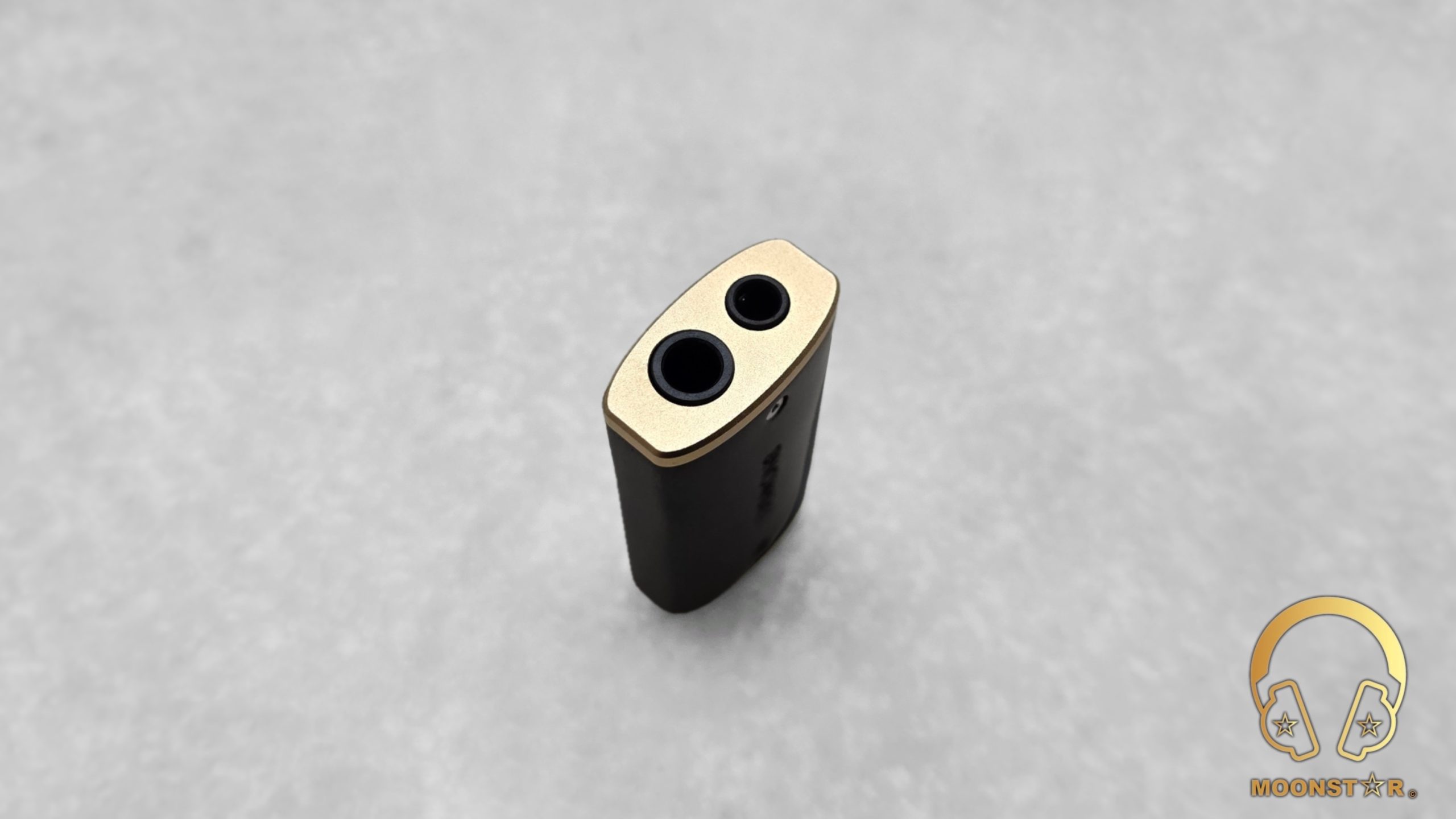
Soundstage & Imaging:
The FiiO SNOWSKY Melody offers a moderately wide soundstage with discernible depth and height for a device of this type. The spatial positioning suggests a coherent three-dimensional space with precise instrument placement. The balanced 4.4mm output appears to enhance separation, where complex instrumental interplay is distinctly defined within the stereo field.
The FiiO FP3 seems to maximize this spaciousness, creating a perceived expansive presentation. The FiiO FD11, with its more intimate tuning, still provides accurate imaging, placing vocals and instruments distinctly. The 3.5mm output offers a slightly narrower stage but retains precise imaging, ensuring a cohesive listening experience across both outputs.

Comparison:
FiiO SNOWSKY Melody versus HIDIZS S8 Pro Robin:
To contextualize the FiiO SNOWSKY Melody’s performance, I compared it with the $99 Hidizs S8 Pro Robin, a mid-range dongle DAC featuring dual ESS Sabre ES9278 chips. The Robin delivers a brighter, more analytical sound, while the Melody leans neutral-warm.
The Melody’s bass stands out with tight, textured sub-bass that remains clear even in dense passages, especially with IEMs like the FiiO FP3. In contrast, the Robin offers more sub-bass impact but with a looser presentation. This boosts energy in bass-heavy genres but may compromise articulation, particularly when paired with sensitive IEMs. In such setups, the Melody’s cleaner output ensures a quieter background.
In the midrange, the Melody excels with natural timbre and balanced warmth, enhancing vocals and instruments with lifelike clarity. Paired with the FD11, it delivers fatigue-free listening across genres. The Robin’s leaner, detail-focused midrange suits critical listening but feels less emotionally engaging for vocal-centric or acoustic material.
Treble presentation further differentiates the two. The Melody offers smooth, extended highs with refined sparkle and no harshness, ideal for long sessions. The FP3 complements this with subtle detail and zero sibilance. The Robin counters with crisper, more forward treble that boosts detail but can introduce fatigue with bright IEMs or recordings.
Soundstage and imaging also favor the Melody. Its 4.4mm balanced output provides a moderately wide and deep stage with precise placement and strong separation. The FP3 enhances this spaciousness, creating a three-dimensional soundfield. The Robin matches width but lacks depth, resulting in a flatter, less immersive presentation despite accurate imaging.
Power output is another key difference. The Melody delivers 250mW (balanced) and 100mW (SE) at 32Ω, offering ample headroom and low noise even in high gain. The Robin’s 300mW suits more demanding headphones but introduces hiss with ultra-sensitive IEMs. Additionally, the Melody supports 10-band EQ and PEQ via the FiiO Control app, while the Robin relies on fixed tuning.
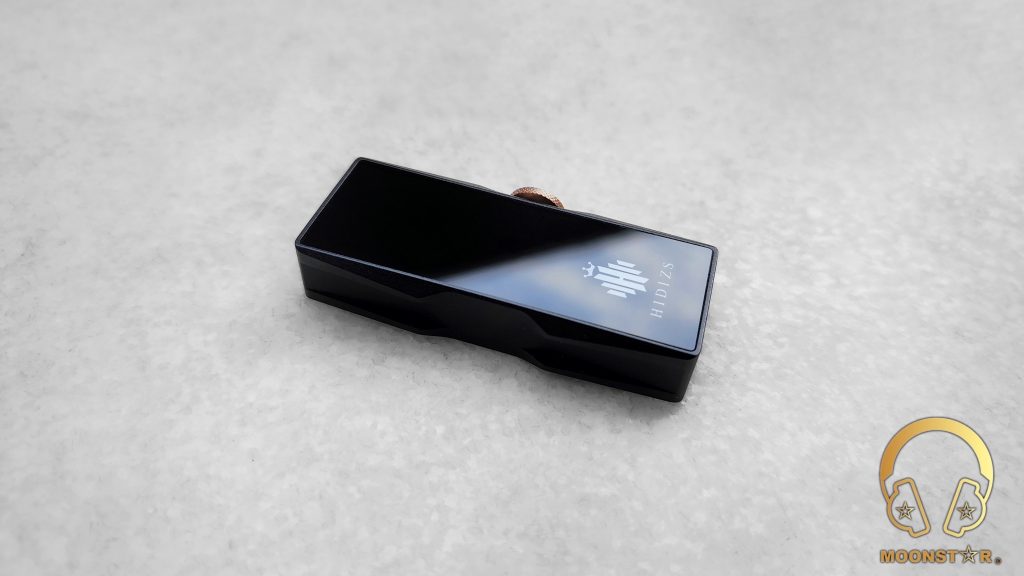
Conclusion:
The FiiO SNOWSKY Melody really stands out in the budget DAC/AMP market, successfully mixing a high-quality build with impressive audio performance. Its neutral-warm sound signature, strong output, and flexible connectivity make it a great choice for listeners seeking a portable yet powerful audio solution. The walnut wood design and optional leather case improve its look, while features like the FiiO Control app with 10-band EQ and PEQ add functionality rarely seen at this price point.
For just $39.99, the FiiO SNOWSKY Melody is an undeniable budget champion. It offers performance that easily competes with, and in some areas surpasses, devices that cost twice as much. While it might not have the raw power for very high-impedance headphones, its overall value and sonic quality are superb, making it a fantastic option for upgrading any mobile audio setup without having to spend over 100.

Pros & Cons:
- + Neutral-warm sound with excellent clarity and detail
- + Premium walnut wood design with a luxurious, artisanal feel
- + Lightweight and compact for ultimate portability
- + Sufficient power for IEMs and easy-to-drive headphones, especially via balanced output
- + Versatile connectivity with 3.5mm and 4.4mm ports, plus SPDIF/coaxial support
- + FiiO Control app with 10-band EQ and PEQ for customizable sound
- + Solid performance and value for the $39.99 price
- – Limited headroom for high-impedance or planar headphones
- – I found no other notable drawbacks at this price level
Thank you for the Read!

